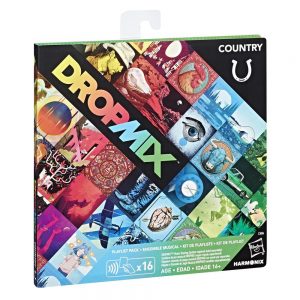Has your enthusiasm for a game caused you to break out in song?
“Shooter Ready – Keeper Ready – Shoot!” was written and performed by members of the Australian Table Football Association (Subbuteo) as the official theme song for the just-finished Asian Cup.
“Push Em Baby” is the new official theme song for the Montreal Chessbrahs team of the PRO Chess League.
- Comments Off on Board Game Theme Songs
 The DropMix music-mixing audio card game was on display Tuesday at CES (the Consumer Electronics Show in Las Vegas), where Hasbro and Harmonix partner NXP Semiconductors is hoping the demonstration will inspire additional uses of its near field communications technology in “areas like consumer engagement in smart toys, smart clothing, smart packages and more.” Fans of the game attending CES will be happy to note that the convention-exclusive Transformers DropMix cards are also being distributed at NXP’s booth (CP-25).
The DropMix music-mixing audio card game was on display Tuesday at CES (the Consumer Electronics Show in Las Vegas), where Hasbro and Harmonix partner NXP Semiconductors is hoping the demonstration will inspire additional uses of its near field communications technology in “areas like consumer engagement in smart toys, smart clothing, smart packages and more.” Fans of the game attending CES will be happy to note that the convention-exclusive Transformers DropMix cards are also being distributed at NXP’s booth (CP-25).
Shipping February 1st is the next DropMix expansion, the Country “Lucky” Playlist Pack, which includes 15 DropMix cards and one hidden track card. with music from Big & Rich, Carrie Underwood, Poison, Sam Hunt, and the Zac Brown Band.
For those interested but previously put off by the game’s full retail price, Amazon is currently offering DropMix at a 50% discount.
- Comments Off on DropMix Country
Musician Composes Album Using Shuffled Deck of Playing Cards
25 Feb
Posted by Lory Gilpatric as Card Games
 This story falls under the “Why didn’t I think of that” category. Wired recently interviewed musician Ben Chasny of the band “Six Organs of Admittance,” because he created what he calls the Hexadonic System for writing music using playing cards.
This story falls under the “Why didn’t I think of that” category. Wired recently interviewed musician Ben Chasny of the band “Six Organs of Admittance,” because he created what he calls the Hexadonic System for writing music using playing cards.
I’ve heard of musicians experimenting with lots of different random patterns to compose songs, like earthquake activity or fractals. But, I’ve never heard of using a deck of playing cards.
After reading the description of how the system works, I can’t believe no one has thought of it before. It is fairly simple.
The first thing Chasny did was assign notes, timing, and structure to each playing card. For example, he lays out 36 cards on the table and assigns them to the frets on his guitar, covering three octaves.
Then, he shuffles the cards and draws six hands, which represent six different scales. Another card is drawn, which is used to represent the timing and order of the notes.
There is a bit more to it than that, but what a great idea. Chesny’s band made an entire album out of this method of songwriting, aptly named Hexadic.
I love random pattern musical experimentation. It is incredible the kinds of sounds that can be produced by such chaos in nature.
I’ll bet one could perform a similar musical experiment using a six-sided die. All you would have to do is assign each number to a chord and then let it role. I think I’m going to try it out right now.
- Comments Off on Musician Composes Album Using Shuffled Deck of Playing Cards
Trending
- Massdrop.com
- Oh the Irony—Illuminati Card Game Continues to Inspire Conspiracy Theorists
- Footprints, an Educational Ecology Game
- Home
- USPS Adds Board Game Flat Rate Box
- Baila, the Estonian Drinking Card Game
- Crystal Caste Wins Dice Patent Suit Against Hasbro
- Mirror Game, Red and Blue
- Are Board Games Dangerous?
- Board Games Based on Hindu Mythology
Archives
Most Popular Articles
- Oh the Irony—Illuminati Card Game Continues to Inspire Conspiracy Theorists
- The 20 Most Valuable Vintage Board Games
- The Truth About Dominoes On Sunday in Alabama
- Sequence Game, and Variants
- USPS Adds Board Game Flat Rate Box
- Baila, the Estonian Drinking Card Game
- The 13 Most Popular Dice Games
- Are Board Games Dangerous?
- Guess Who? The Naked Version
- What Happened to the Jewel Royale Chess Set?
Recent Posts
- Toy Fair 2019—Breaking Games
- Talisman Kingdom Hearts Edition
- Toy Fair 2019—Winning Moves
- Toy Fair 2019—Games Workshop
- Toy Fair 2019—Star Wars Lightsaber Academy
- Toy Fair 2019—Stranger Things Games
- Toy Fair 2019—HABA
- Licensing Roundup
- Game Bandit
- 2018 A Difficult Year For Hasbro But Not For D&D Or MtG
Recent Comments
- on Toy Fair 2019—Winning Moves
- on Game Bandit
- on Second Look—Dungeons & Dragons Waterdeep Dragon Heist
- on Crowdfunding Highlights
- on Beyblade SlingShock
- on Game Bandit
- on Game Bandit
- on Watch This Game!, the Board Game Review Board Game
- on Second Look—Vampire: The Masquerade 5th Edition
- on Palladium Books Loses Robotech IP License, Cancels Five-Year-Overdue Robotech RPG Tactics Kickstarter




